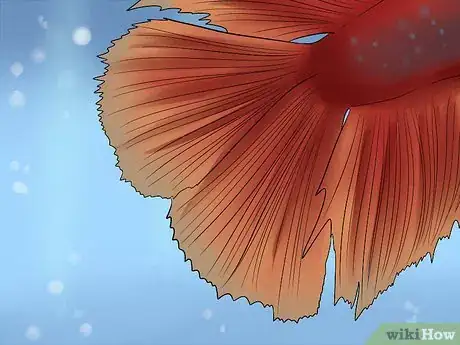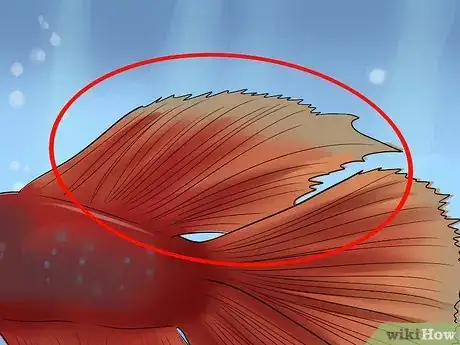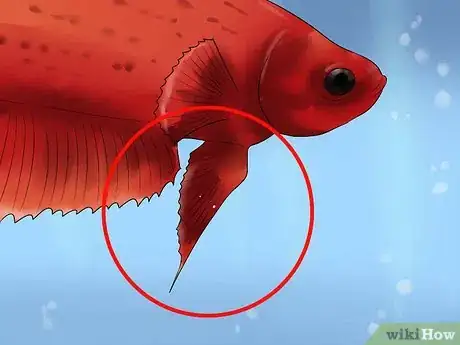This article was co-authored by Pippa Elliott, MRCVS. Dr. Elliott, BVMS, MRCVS is a veterinarian with over 30 years of experience in veterinary surgery and companion animal practice. She graduated from the University of Glasgow in 1987 with a degree in veterinary medicine and surgery. She has worked at the same animal clinic in her hometown for over 20 years.
There are 7 references cited in this article, which can be found at the bottom of the page.
wikiHow marks an article as reader-approved once it receives enough positive feedback. In this case, several readers have written to tell us that this article was helpful to them, earning it our reader-approved status.
This article has been viewed 371,648 times.
Betta fish, also known as Siamese fighting fish, are one of the most common aquarium pets.[1] In addition to being visually stunning, they are also very curious and friendly creatures if kept singly.[2] Learning to identify the physical characteristics of Betta fish can make it even more rewarding to observe them in their environment.
Steps
Examining a Betta Fish’s Tail Fin
-
1Examine the short length a Betta fish’s tail. Betta fish have a variety of tail types. One simple way to identify a Betta fish is by the length of its tail. Short tails are common in wild type Bettas, as well as Bettas that are bred to fight.[3]
- Short-finned Bettas, which are also called Plakats, are sometimes bred to have D-shaped tails.[4]
- Since female Bettas typically have shorter tails than male Bettas, it can be challenging to determine the sex of short-finned Bettas.
-
2Identify a long tail length. Some Betta fishes will have long and flowing tails, which can be beautiful to look at. Long tails come in different shapes, such as veiled, halfmoon, and delta. Veiltail Betta are one of the most common types of Betta fish, and one of the most popular types of pet fish.[5]
- The veiltail is long and flowing.[6] It arches up and over the body, resembling a veil.[7] The tail is usually asymmetric and broad at its base, and more pointed at its outer edge.
- The half-moon tail looks like a half-circle or a capital ‘D.’ The perfect halfmoon shape has a spread of exactly 180° between the top and bottom tail rays. Sometimes, the half-moon shape can only be seen when the betta flares. [8] Halfmoon tails are usually very fragile.
- There are also ‘over half-moon’ tails, which extend beyond a 180° tail spread angle.[9]
- Delta tails are in the shape of a D but do not achieve a 180° tail spread angle.[10] Delta tails are sometimes called ‘Super Deltas,’ with a tail spread angle of 160° to 179°.
- The Delta tail usually has rounded edges, but the Super Delta tail tends to have a broad base and a wide end.
Advertisement -
3Determine if a Betta fish has a double tail. As the name suggests, Double Tail Bettas have two distinct tails due to a genetic mutation. They also have shorter bodies, making them prone th swim bladder disorder Ideally, the two tails are clearly split at the tail base. Double Tail Betta fish usually have a doubling and/or widening of their unpaired fins (dorsal and anal fins).[11]
-
4Identify a crown tail. The crown tail has reduced webbing and individual tail rays that extend out.[14] Crown tails come in a variety of colors and can be quite striking to observe. Crown Tail Bettas are becoming increasingly popular in pet stores.
- The rays of a crown tail are typically long and straight, but may start to curl in response to unfavorable water conditions.[15]
- Crown tails may be long or short. They are typically shorter on female Bettas than male Bettas.
Observing the Color Pattern of a Betta Fish
-
1Look at the solid coloration of a Betta fish. Betta fish have been bred to come in a wide range of solid colors, including black, red, blue, and white. There can even be variations within a particular color family. For example, the coloration of a red Betta fish can range from bright to deep.
- Betta fish that are red as juveniles may lose their coloration as adults due to the Red Loss gene.[16]
- For black Betta fish, the ideal coloration is pitch-black, or melano black. It is caused by a gene mutation that results in increased melanin. Melano females cannot breed eggs that will hatch, as the mutation kills the eggs. [17]
- Black Betta fish are usually a smoky black.[18]
- Some solid-colored Bettas will have a metallic look, due to pigment-containing cells called chromatophores.[19]
-
2Identify different solid colors on the body and fins. A Betta fish with one solid color on its body and another on its fins is considered bi-colored. Either the body is dark with light fins, or vice versa. There should be a sharp contrast and divide between the two colors. Two types of bi-colored Betta are butterfly and Cambodian.[20]
- Butterfly Bettas have solid colors on their bodies, which partially extends to their unpaired fins. The outer edge of the fins will be a different color, creating a distinct band of color.[21]
- Some butterfly Bettas have three colors, and therefore do not fit the strict definition of bi-colored. The three colors will still be distinct. An example of a tri-colored Betta fish is the Thai Flag Betta (red, white, and blue).[22]
- Cambodian Bettas have flesh-colored bodies and deep red fins. Cambodian Bettas have lost popularity as new color patterns have been introduced.[23]
-
3
-
4Look for a copper color pattern. The copper pattern actually contains a variety of colors (e.g., lavender, turquoise, purple), and is most obvious with the light from a flashlight. Ideally, there should be a roughly even distribution of colors between the body and fins. The body of a copper Betta will usually be blue with a metallic cover.[28]
-
5Identify flecks of color on a Betta fish. Betta fish with speckles or flecks of color are called grizzle Betta. Grizzle Betta will have random flecks or spots of color on their bodies and fins. The random coloration is usually iridescent.[29]
Identifying Male and Female Betta Fish
-
1Observe the coloration and fin shape. In general, female Bettas are less colorful than male Bettas. In addition, the female Betta tails are not as long or showy as those on male Bettas. In fact, the female Betta tail is more likely to be round.[30]
- Because young male Bettas do not have long fins, fin shape cannot be reliably used to determine sex in young Bettas.[31]
-
2Look for a beard. The beard is not an actual beard. – It is a membrane under the gill cover. In males, it can be seen when the gill covers are closed or open. Female Bettas also have a beard, but it is visible only when the gill covers are open.[32]
- Male Bettas flare (open their gill covers and expand their beard) to make themselves look bigger to another male Betta.[33]
-
3Identify a small white dot behind the ventral fin (underside front fin). The small white dot is present only on females. It is the ovipositor or ova—the location where a female produces her eggs. This small white dot is more apparent in an adult female Betta. Please keep in mind that males can have fake egg spots, so looking for an egg spot is not the best way to confirm a betta’s gender. [34]
- The ova may be difficult to identify in a young female Betta, making it more challenging to determine the sex.[35]
Warnings
- Male and female Bettas should not be housed together unless they are breeding. The male Betta may antagonize his female counterpart, and may even try to kill her.⧼thumbs_response⧽
- Male Bettas are territorial and should not be housed together. If more than one male Betta fish is in a tank, they may fight to the death.⧼thumbs_response⧽
References
- ↑ http://Bettasource.com/Bettas/
- ↑ http://Bettasource.com/Bettas/
- ↑ http://Bettasource.com/Bettas/tail-types/
- ↑ http://Bettasource.com/Bettas/tail-types/
- ↑ http://Bettasource.com/Bettas/tail-types/
- ↑ http://bettasource.com/bettas/tail-types/
- ↑ http://bettasource.com/bettas/tail-types/
- ↑ http://Bettasource.com/Bettas/tail-types/
- ↑ http://Bettasource.com/Bettas/tail-types/
- ↑ http://bettasource.com/bettas/tail-types/
- ↑ http://Bettasource.com/Bettas/tail-types/
- ↑ http://Bettasource.com/Bettas/tail-types/
- ↑ http://Bettasource.com/Bettas/tail-types/
- ↑ http://Bettasource.com/Bettas/tail-types/
- ↑ http://Bettasource.com/Bettas/tail-types/
- ↑ http://Bettasource.com/Bettas/colors/
- ↑ http://Bettasource.com/Bettas/colors/
- ↑ http://bettasource.com/bettas/colors/
- ↑ http://Bettasource.com/Bettas/colors/
- ↑ http://bettasource.com/bettas/colors/
- ↑ http://Bettasource.com/Bettas/colors/
- ↑ http://Bettasource.com/Bettas/colors/
- ↑ http://Bettasource.com/Bettas/colors/
- ↑ http://bettasource.com/bettas/colors/
- ↑ http://Bettasource.com/Bettas/colors/
- ↑ http://Bettasource.com/Bettas/colors/
- ↑ http://Bettasource.com/Bettas/colors/
- ↑ http://Bettasource.com/Bettas/colors/
- ↑ http://Bettasource.com/Bettas/colors/
- ↑ http://www.Bettafishcenter.com/Betta-Behavior.shtml
- ↑ http://fighterfish.org/?p=356
- ↑ http://fighterfish.org/?p=356
- ↑ http://www.Bettafishcenter.com/Betta-Behavior.shtml
- ↑ http://www.Bettafishcenter.com/Betta-Behavior.shtml
- ↑ http://www.Bettafishcenter.com/Betta-Behavior.shtml
- ↑ http://fighterfish.org/?p=356
About This Article
To identify different Betta fish, start by examining the characteristics of its tail. If a fish has a long, flowing tail that arches up and over the body, it’s likely a Veiltail Betta. Alternatively, if the tail is short and D-shaped, it’s a short-finned Betta, also called a Plakat. Next, look for the fish's color patterns to see if it's one solid color on its body and another on its fins, which indicates a bi-colored Betta. If the fish has 3 distinct colors, such as red, white, and blue, you're looking at a tri-colored Betta. For more tips from our Veterinary co-author, like how to identify the sex of a Betta fish, read on!









































































